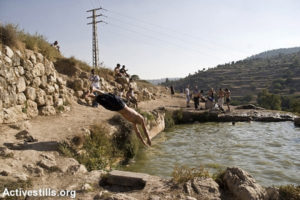Jerusalem Illegally Razes Four Palestinian Buildings, Clearing Way for a New Park

Ein Haniya, a natural spring on the outskirts of the Palestinian village of al-Walajeh,
Jerusalem demolished four Palestinian-owned buildings without a demolition order, as part of its preparations to open a new park in the city’s south.
The buildings belong to residents of Al-Walaja, a Palestinian village located near the Ein Haniya spring.
The demolitions took place just two weeks after the High Court of Justice barred the Jerusalem Municipality from demolishing dozens of other houses in Al-Walaja without first reviewing a plan presented by local residents to legalize their construction.
Ein Haniya is a large natural spring on Jerusalem’s southern edge. Two and a half years ago, the city finished refurbishing the spring and inaugurated the area as a park in a gala ceremony.
But the park was closed immediately afterward because police refused to grant it a license until a nearby military checkpoint was moved to a location that would prevent Palestinians from accessing the park. A dispute then erupted between the Israel Nature and Parks Authority and the Jerusalem Development Authority over who would pay for the park’s maintenance and whether an admissions fee would be charged.
Recently, however, the two agencies resumed preparations to finally open the park to the public. These preparations included what the city termed “removing eyesores” – namely, the four buildings owned by Al-Walaja residents, as well as several huts that serve the village’s farmers.
“We’ll do everything in our power to encourage them – not just to enable them, but to encourage them,” the director of the nature authority’s Jerusalem region, Zeev Hacohen, said of the Palestinian farmers during one of the deliberations on the plan. But in practice, the farmers have been suffering greatly from the work to build the park.
The razed buildings were decades old. At least one was built before Israel’s establishment in 1948 and was made from local stone. Several years ago, when Al-Walaja was surrounded by the separation fence, these buildings remained on the Israeli side of the barrier, making access to them difficult. Nevertheless, all of them remained in use.
One building, which is actually an expansion of a cave, became the home of a family whose other house was destroyed by the Jerusalem Municipality a year ago. The others were used by farmers to store equipment, or as a place of residence, but were abandoned after the separation fence was built.
All the buildings, including the huts, were razed without a demolition order and without their owners being given advance notice.
“My grandfather built this house,” said Fayez, the owner of one destroyed home, who asked to be identified only by his first name. “Someone named Zohar, who is responsible for the checkpoint, told me, ‘This is Israeli territory, you have to leave.’ I told him it has nothing to do with whether the territory is or isn’t Israeli; we have land and homes here and we’re all human beings.
“These are decades-old homes,” said Aviv Tatarsky, a researcher for the Ir Amim organization, which has been helping Al-Walaja residents for years. “Generation after generation has lived in them, cultivated gardens around them and worked magnificent terraces of olive groves. Al-Walaja residents’ connection to their land and their heritage was stronger than Israel’s efforts to expel them by building the separation fence, and they continued to come and work their lands.
“Destroying these homes is further proof of the state’s warped thinking,” Tatarsky added. “In order for Israelis to dangle their feet in the Ein Haniya spring, which was taken from the village, it’s necessary or justified to forcibly expel the Al-Walaja community from its lands.”
Two weeks ago, however, Al-Walaja residents won an important victory at the High Court when the justices froze demolition orders against dozens of buildings in the village.
Though part of the village is located within Jerusalem’s municipal boundaries, residents receive no services from the municipality or any other Israeli agency. “The only service we get is house demolitions – not electricity, not water, not garbage collection,” village resident Ibrahim al-Arraj said.
This means that getting permits to build legally in the village is impossible. So for lack of any other choice, residents build illegally.
Two years ago, dozens of village residents asked the Jerusalem District Court to order the Jerusalem district planning committee to consider a master plan they prepared for the village in an effort to legalize the buildings slated for demolition. After the district court rejected their petition, they appealed to the High Court. And two weeks ago, the court froze the demolitions until the planning committee considers their proposed master plan.
This article is published in its entirety.
